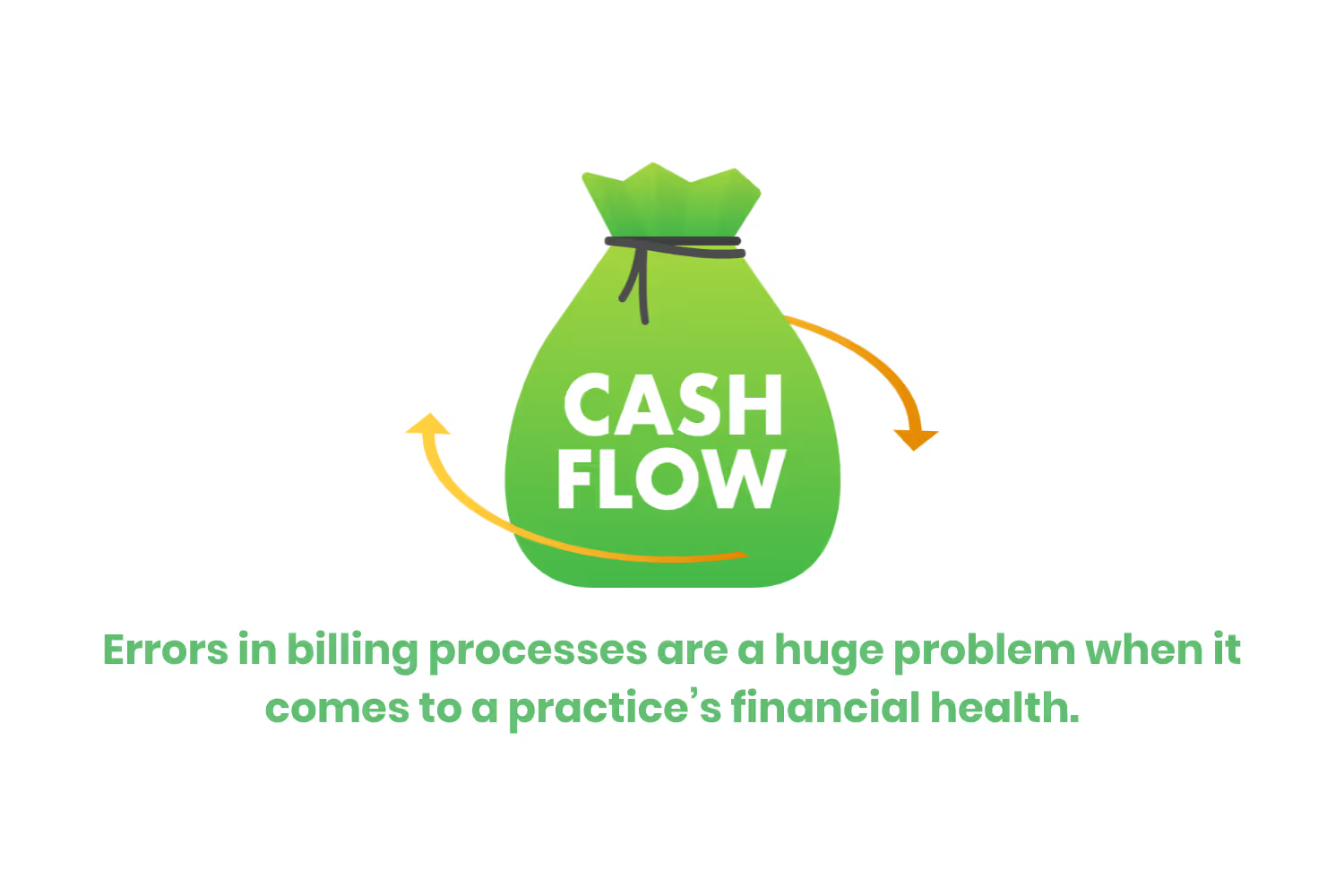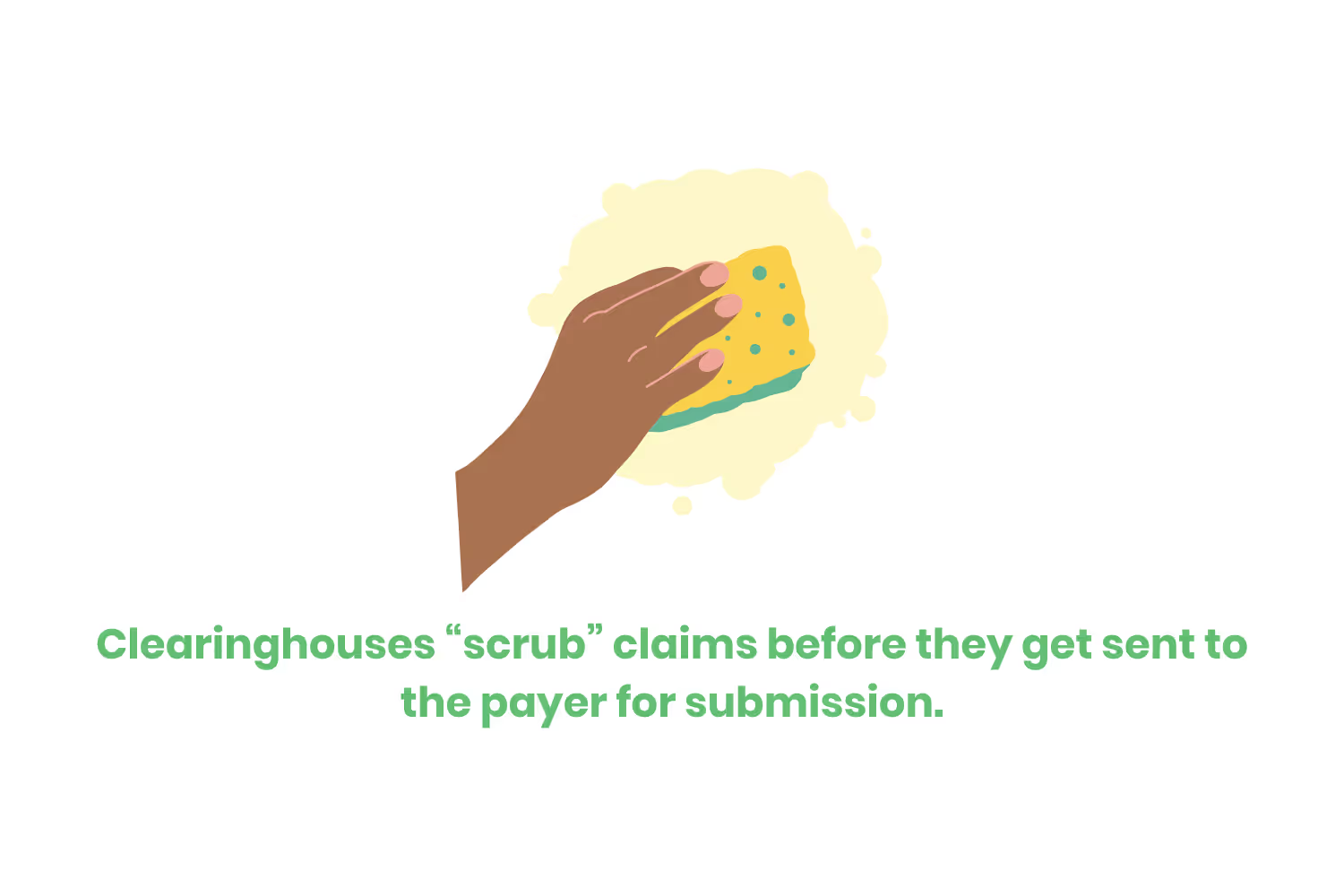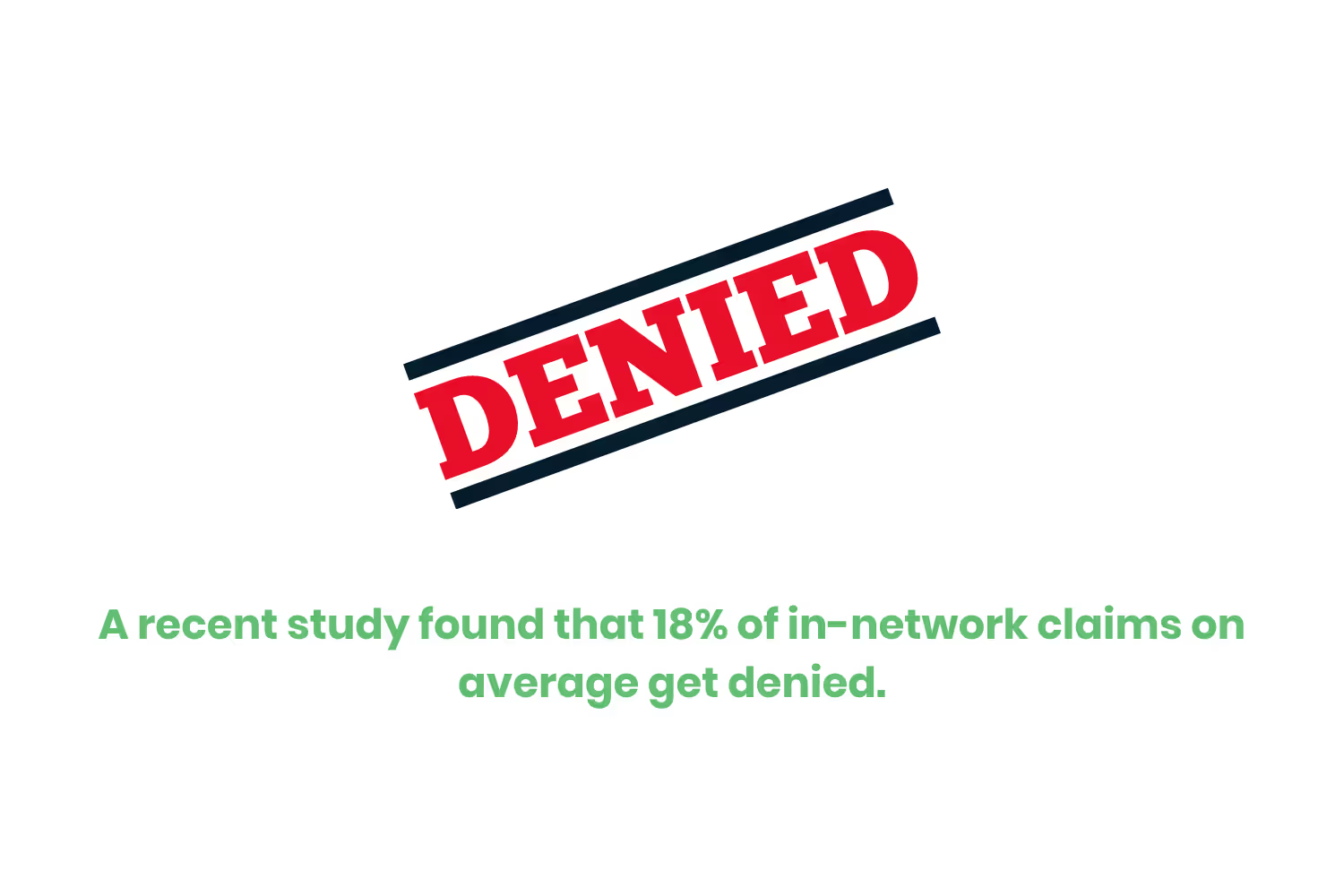The 13 KEY Steps Of Revenue Cycle Management
Let’s take a look at the 13 steps of revenue cycle management that everyone should know!

Over 80% of medical bills contain at least one error.
Errors in billing processes are a huge problem when it comes to a practice’s financial health. Errors directly result from issues in your revenue cycle, thus causing delayed payments. These delays can last for days, weeks, or even months!

It all depends on when insurance companies process your claim and send back a denial code for your medical billing team to review again. Denial codes, at the end of the day, are one of the main reasons your payment gets delayed. Denials leave you waiting on payments from not only the insurance company but your patients as well.
The goal of Revenue Cycle Management (RCM) is to help streamline your medical billing process, allowing for minimal errors. Avoiding these issues will decrease the time it takes for you to receive payments over time. There are many reasons you may experience a delay in collecting your revenue. To understand these reasons, it helps to be able to visualize the entire RCM process.
So let’s take a look at the 13 steps of revenue cycle management that everyone should know!
Step 1: Appointment Scheduling
The beginning of the cycle starts when the patient makes an appointment. Whether it’s over the phone or online. Utilizing Electronic Health Records (EHR) systems makes this step simple.
At the same time, keeping all of your patient’s protected health information (PHI) secure and in one spot.
You can use this step to add any important notes to the patient's file, such as why they are coming in for their appointment. This will help make sure the patient is seeing the correct physician for their specific needs.

Step 2: Patient Registration
When the patient comes in for the appointment they will need to provide personal data such as an address, form of identification, and so on. During this step, they must fill out all necessary forms, including prior medical history and emergency contacts. It is also essential for patients to sign consent forms before receiving any services.
During this time you should also have your patient read over your practice collection policy and procedures. This helps to define your company’s payment terms upfront, helping to reduce the rate of late payments in the future.
Step 3: Insurance Verification
As I mentioned earlier, verifying the patient’s insurance is vital. Especially before they receive any services from the provider.
Confirming the patient’s insurance covers a wide variety of information including their:
- Copay
- Deductible
- Overall coverage
- Out-of-pocket maximum

Finding out who’s responsible for what when it comes to payment, whether it be the patient or the insurance company, keeps everyone on the same page.
It also gives patients the chance to ready their finances before receiving medical care. Or to possibly negotiate a payment plan beforehand, reducing the amount of overdue payments.
Verifying insurance facilitates better communication between the provider and the patient.
Step 4: Prior Authorization
Outside of general office visits, some procedures may need something called “prior authorization”.
This step is very important to help ensure a streamlined and high-functioning revenue cycle process. Receiving prior authorization can be an extensive process, however, depending on the procedure. The provider must reach out to the patient's insurance provider first with a request.
The insurance company may request documentation from the physician’s office before approving or denying the request. Of course, there may be situations where the patient may need to inquire about prior authorization, but usually, this falls on the shoulders of the provider.
Pay close attention to your process during this step, otherwise it might result in prior authorization denials.

Step 5: Providing Services
Did you know that 38% of Americans said they skipped/delayed visiting a medical provider?
As much as we all hate going to the doctor, it’s necessary for our health. Similarly, the revenue cycle is necessary for your provider’s financial health.
So as straightforward as this step is, let’s talk about it.
Providing care is arguably the most important step. After all, you have the well-being and sometimes even the life of a patient in the palm of your hands.
Making sure to accurately document and summarize a patient’s visit is key. So that your medical billing and coding team can easily put together a claim, avoiding any errors or misunderstandings.

Step 6: Medical Coding
Medical billing and coding teams work with Current Procedural Terminology (CPT) codes to categorize all services and procedures.
This universal coding system is helpful because all insurance companies understand and accept it.
CPT codes help to facilitate billing, reporting, and administration, increasing the accuracy of your revenue cycle system.
Step 7: Submission to Clearinghouse
To help make sure your medical billing and coding team did not make any errors, you might consider utilizing a third-party clearinghouse. These companies are an essential safety net when it comes to keeping your claim denial rate low. This is because clearinghouses “scrub” claims before they get sent to the payer for submission.
If there were to be any errors, the claim goes back to the provider to receive readjustments. This is highly favorable, as sending a claim with errors straight to a payer could result in your practice waiting days, weeks, or even months!
While clearinghouses send back claims with errors right away. Lessening the amount of time you have to wait for your revenue.

Step 8: Sending to The Payer
After the clearinghouse scrubs the data, if there is an error, it comes right back to your billing team for fixing.
This way, the provider has a chance to adjust any issues with the claim before sending it off to the payer. Overall, saving everyone time and energy.
However, if there are no errors, it will then go straight to the patient's insurance company. One step closer to collecting that revenue!
Step 9: Claim Adjudication
When the insurance company finally receives the claim, they will begin to review it. The insurance company will review for accuracy and compliance with their specific policies. This step also goes by the term “claim adjudication”.
This step determines what services the insurance provider will reimburse, depending on the patient’s:
- Insurance plan
- Deductibles
- Co-pays
- Coverage limitations
If they see a discrepancy, they will deny the claims and delay the revenue that the physician is expecting. But hopefully, the claim went through the clearinghouse process first!

Step 10: Claim Denials
Speaking of denying claims, let’s look into what that process entails. A recent study found that 18% of in-network claims on average get denied. That’s a large chunk of missing revenue! There are a few different reasons for a denied claim.
Here are some of the most common reasons for receiving a denial code:
- Coding error
- The service is “experimental”
- Did not receive prior authorization
- The patient visited an out-of-network provider
Insurance companies then send the denial code back to the billing department, with information on what the error is.

Step 11: Claim Resubmission
Depending on why you receive a claim denial, there are different ways to proceed moving forward. You can reach out to the insurance company for more information, but you want to focus on a few things.
When investigating the denial, make sure to provide any additional information you may have overlooked before. Documentation is key when appealing your case.
You can typically complete this process online. Having to deal with multiple claim denials is detrimental to your organization's financial standing. It further delays the time between physicians rendering services and collecting revenue.
Step 12: Posting Bills
Once the insurance company looks over the claim and figures out how much they will cover, the physician can then collect their revenue.
The payment then posts on the patient’s account.
This makes it simple for billing teams to deduce the remaining balance due, which is the responsibility of the patient. The billing team will then contact the patient requesting that balance.
Step 13: Patient Payment
The last step is to simply collect payment from the patient. But if you work in healthcare, you know it’s really not that simple.
Remember to offer various methods of collecting payments. This makes it easier and more accommodating for your patients to pay their bills on time.
You can accept cash, check through the mail, take payments over the phone, or offer the option of an online payment portal for their convenience. If there is no response from the patient, you may need to follow up with a letter or another form of communication to make sure they are receiving invoices.

Conclusion
Having a streamlined revenue cycle is crucial when it comes to receiving revenue as soon as possible. Knowing each step of the process allows you to not only familiarize yourself with how everything works but the possible issues that might arise. Therefore, allowing you to better prevent them from happening in the first place!
By staying up to date with the latest RCM technology and trends, while also keeping your team in the loop with industry standards, you can avoid serious financial loss. While also keeping your professional reputation among colleagues and your clientele strong.
Emphasize your product's unique features or benefits to differentiate it from competitors
In nec dictum adipiscing pharetra enim etiam scelerisque dolor purus ipsum egestas cursus vulputate arcu egestas ut eu sed mollis consectetur mattis pharetra curabitur et maecenas in mattis fames consectetur ipsum quis risus mauris aliquam ornare nisl purus at ipsum nulla accumsan consectetur vestibulum suspendisse aliquam condimentum scelerisque lacinia pellentesque vestibulum condimentum turpis ligula pharetra dictum sapien facilisis sapien at sagittis et cursus congue.
- Pharetra curabitur et maecenas in mattis fames consectetur ipsum quis risus.
- Justo urna nisi auctor consequat consectetur dolor lectus blandit.
- Eget egestas volutpat lacinia vestibulum vitae mattis hendrerit.
- Ornare elit odio tellus orci bibendum dictum id sem congue enim amet diam.
Incorporate statistics or specific numbers to highlight the effectiveness or popularity of your offering
Convallis pellentesque ullamcorper sapien sed tristique fermentum proin amet quam tincidunt feugiat vitae neque quisque odio ut pellentesque ac mauris eget lectus. Pretium arcu turpis lacus sapien sit at eu sapien duis magna nunc nibh nam non ut nibh ultrices ultrices elementum egestas enim nisl sed cursus pellentesque sit dignissim enim euismod sit et convallis sed pelis viverra quam at nisl sit pharetra enim nisl nec vestibulum posuere in volutpat sed blandit neque risus.

Use time-sensitive language to encourage immediate action, such as "Limited Time Offer
Feugiat vitae neque quisque odio ut pellentesque ac mauris eget lectus. Pretium arcu turpis lacus sapien sit at eu sapien duis magna nunc nibh nam non ut nibh ultrices ultrices elementum egestas enim nisl sed cursus pellentesque sit dignissim enim euismod sit et convallis sed pelis viverra quam at nisl sit pharetra enim nisl nec vestibulum posuere in volutpat sed blandit neque risus.
- Pharetra curabitur et maecenas in mattis fames consectetur ipsum quis risus.
- Justo urna nisi auctor consequat consectetur dolor lectus blandit.
- Eget egestas volutpat lacinia vestibulum vitae mattis hendrerit.
- Ornare elit odio tellus orci bibendum dictum id sem congue enim amet diam.
Address customer pain points directly by showing how your product solves their problems
Feugiat vitae neque quisque odio ut pellentesque ac mauris eget lectus. Pretium arcu turpis lacus sapien sit at eu sapien duis magna nunc nibh nam non ut nibh ultrices ultrices elementum egestas enim nisl sed cursus pellentesque sit dignissim enim euismod sit et convallis sed pelis viverra quam at nisl sit pharetra enim nisl nec vestibulum posuere in volutpat sed blandit neque risus.
Vel etiam vel amet aenean eget in habitasse nunc duis tellus sem turpis risus aliquam ac volutpat tellus eu faucibus ullamcorper.
Tailor titles to your ideal customer segment using phrases like "Designed for Busy Professionals
Sed pretium id nibh id sit felis vitae volutpat volutpat adipiscing at sodales neque lectus mi phasellus commodo at elit suspendisse ornare faucibus lectus purus viverra in nec aliquet commodo et sed sed nisi tempor mi pellentesque arcu viverra pretium duis enim vulputate dignissim etiam ultrices vitae neque urna proin nibh diam turpis augue lacus.



![[ANSWERED] What is a Long-Term Care (LTC) Pharmacy](https://cdn.prod.website-files.com/67e2b8210878abcba6f91ae6/68d687806a075a1cf64659b0_WhatisLongTermCarePharmacy_925.avif)
